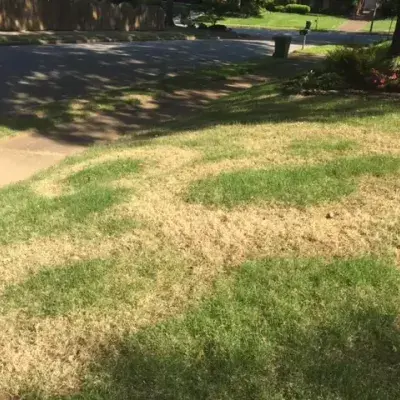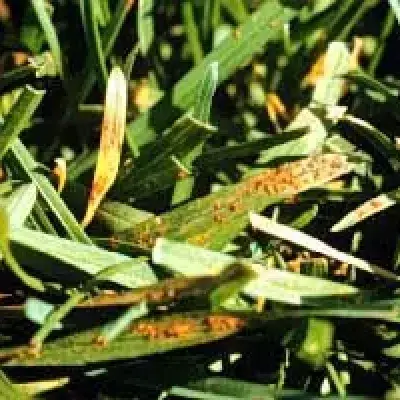Lawn diseases and fungus can be a major problem for Memphis homeowners. In summer months, lawns in the Memphis area are particularly prone to fungal infections. Common lawn diseases and fungi in this region include Brown Patch, Zoysia Patch, Dollar Spot, Fairy Rings, Powdery Mildew, Rust, and Spring Dead Spot. Contact Herbi-Systems for lawn disease and fungicide treatments in Memphis and the surrounding areas.
Brown Patch
Brown Patch is a fungal disease that attacks various types of turf grass. It is typically caused by the fungus Rhizoctonia solani. This disease appears in warm, humid weather and can quickly spread across an entire lawn if not treated properly. Brown patch forms large, uneven circles with a gray-to-brown coloration. Bermuda, Fescue, and Zoysia grasses are particularly susceptible to brown patches.

Zoysia Patch
The close cousin of Brown Patch, Zoysia Patch is a fungal disease that attacks Zoysia grasses. It thrives in warm, humid climates and is particularly common in the Mid-South area. This fungus can quickly spread across a lawn if not treated properly, forming large circles with a yellowish-brown coloration. Mowing height, management practices, and weather conditions contribute to this disease. Applying too much fertilizer is a major factor that increases susceptibility.

Dollar Spot
Dollar Spot is caused by a different fungus and usually presents with a small, patchy spotting as the grass dies off and ranges in color from tan to straw. This type of disease thrives in cool, wet weather and is most common during spring or fall. Dollar Spot can affect any type of turfgrass, but Bermuda and Fescue grasses are particularly susceptible. This disease is typically caused by low nitrogen in the soil and can spread across a lawn if not treated properly, forming large circles with a yellowish-brown coloration.

Fairy Rings
Fairy Rings, on the other hand, are caused by a different kind of fungus that lives in the thatch layer of grass. Fairy Rings usually create dark green circles in the lawn, and all types of grass can be susceptible to this type of disease. This type of fungus thrives most when there is an abundance of organic matter, such as compost or mulch, in the soil. While this disease can spread across a lawn and create large circles of yellowish-brown coloration, it is typically more localized and less damaging than other types of lawn diseases.

Powdery Mildew
Powdery mildew is a common lawn disease that can occur in any grass species, including Bermuda and Zoysia. It appears as lime-colored dust on the grass blades, and it can cause patchy discoloration to occur. This type of fungus thrives most when there is too much shade, fertilizer, and moisture in an area, as well as not enough air circulation.

Rust
Rust is another lawn disease that can occur in Bermuda and Zoysia grasses. It presents with a rust-to-orange coloration due to spores that build up on the blades of grass. This disease favors warm, damp weather where the grass does not dry out during periods of long-lasting dew (up to 10 hours, particularly during overcast and damp days). Any contact in moving through the infected areas spreads the spores.

Spring Dead Spot
Spring dead spot appears in the spring as small, circular dead areas of Bermuda grass, 6 inches to several feet in diameter. This disease occurs in the spring as Bermuda grass resumes growth from winter dormancy. The Bermuda grass roots and stolons in affected spots appear dark and rotted. The grass recovers very slowly during summer months while stolons creep in from the border of affected areas. Bermuda grass stolons that grow into the affected areas usually produce short, stubby roots. The dead spot can only be treated when active. The applications must begin in late summer or early autumn when the fungus is believed to be active.




Comments (0)
Thanks for your comment!
Thanks for your feedback! Your comments have been successfully submitted! Please note, all comments require admin approval prior to display.
Error submitting comment!
There is a problem with your comment, please see below and try again.